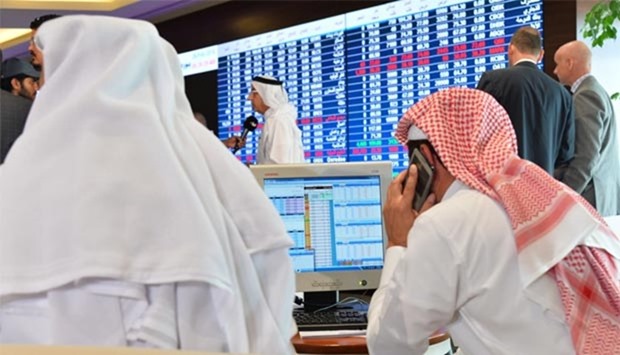Precipitous decline, especially in the large cap stocks, was instrumental in dragging the market during the week which saw QSE’s announcement to shift Mannai Corporation from industrials group to consumer goods segment, effective from October 1.
Foreign institutions turned net profit takers to drive the QSE key index down 2.79% during the week which saw Qatari Investors Group to replace Al Meera Consumer Goods Company in the main barometer from next month.
The bearish sentiments in the QSE was rather strongest in the Gulf Cooperation Council region as Bahrain had fallen 2.03%; whereas Saudi Arabia gained 2.57%, Muscat (1.11%), Abu Dhabi (0.8%), Kuwait (0.37%) and Dubai (0.21%) during the week which witnessed Arab Petroleum Investment Corporation view that Qatar will continue to rely heavily on independent water and power projects in the medium term to add capacity.
Selling pressure – especially in telecom, banking and realty counters – had an overarching influence during the week which saw Standard and Poor’s (S&P), a global credit rating agency, forecast that huge infrastructure investment will support Qatar’s growth over 2016-2019.
Trading turnover and volumes were also on the decline during the week which saw S&P say that Qatar's foreign reserves are expected to fall over the next year as net portfolio outflows, linked to its sovereign wealth fund's activities, are likely to remain strong thereby keeping the financial account in deficit.
The Qatari bourse has however made 1% gains year-to-date compared to 11.69% in Dubai, 6.87% in Muscat and 4.86% in Abu Dhabi; whereas Saudi Arabia plunged 10.64%, Bahrain (7.88%) and Kuwait (3.31%).
However, local retail investors turned bullish and there was increased buying support from their non-Qatari counterparts in the QSE, where banking, real estate and industrials together constituted about 73% of the total trading volume.
Domestic institutions continued to be net sellers but with much lesser intensity during the week which saw six of the seven sectors reel under selling pressure.
Opening the week weak at 10,850 points, the market kept gaining for the rest of the session due to lack of positive triggers and on account of holidays in the coming week and thus settle at 10,534 points.
Tracking the main barometer, the 20-stock Total Return Index shed 2.79%, All Share Index (comprising wider constituents) by 2.53% and Al Rayan Islamic Index 2.59% during the week which saw Ministry of Development Planning and Statistics data suggest that costlier food items and transportation led Qatar's cost of living, based on consumer price index, rise 0.2% in August against the previous month's levels.
Telecom stocks plunged 3.79%, banks and financial services (3.74%), realty (2.66%), transport (2.06%), industrials (1.47%) and consumer goods (1.1%); while insurance gained 0.88% during the week which saw Masraf Al Rayan dominate the trading ring in terms of volume and value.
Market capitalisation eroded 2.68% to QR565.19bn as large, micro, small and midcap equities lost 3.42%, 0.79%, 0.62% and 0.61% respectively during the week.
Micro and large cap stocks have gained year-to-date 1.55% and 0.74%; while small and midcaps shrank 2.99% and 2.76% respectively.
Of the 44 stocks, as many as 32 declined, while only 11 advanced and one was not traded during the week. As many as 10 of the 13 banks and financial services; six of the nine industrials; five of the eight consumer goods; all of the four real estate; three of the five insurers; and two each of the three transport and the two telecom stocks ended in the red during the week.
More than 74% of the stocks returned losses with major shakers being Ooredoo, Commercial Bank, Qatar Islamic Bank, QNB, Industries Qatar, Masraf Al Rayan, Ezdan and Nakilat; even as al khaliji, Aamal Company, Gulf International Services and Qatar Insurance bucked the trend during the week.
Foreign institutions turned net sellers to the tune of QR4.92mn compared with net buyers of QR284.82mn the previous week.
However, domestic institutions’ net profit booking fell substantially to QR132.26mn against QR314.97mn the week ended September 1.
Local retail investors turned net buyers to the extent of QR80.02mn compared with net sellers of QR6.81mn the previous week.
Non-Qatari individual investors’ net buying increased to QR57.16mn against QR36.97mn the week ended September 1. Total volume fell 12% to 32.21mn shares and value by 15% to QR1.45bn but on 10% jump in transactions to 25,450 during the week.
There was 23% plunge in the industrials sector’s trade volume to 5.22mn equities and 6% in value to QR330.35mn but on 2% rise in deals to 5,477.
The consumer goods sector’s trade volume plummeted 21% to 1.2mn stocks and value by 16% to QR57.53mn; while transactions were up 9% to 1,343.
The insurance sector reported 20% shrinkage in trade volume to 0.61mn shares, 20% in value to QR50.67mn and 13% in deals to 749.
The transport sector’s trade volume tanked 18% to 2.4mn equities and value by 25% to QR73.61mn; whereas transactions rose 23% to 1,902.
The real estate sector saw 16% decline in trade volume to 6.02mn stocks and 13% in value to QR132.94mn but on 37% increase in deals to 4,333.
The telecom sector’s trade volume shrank 12% to 4.57mn shares and value by 43% to QR136.76mn; while transactions rose 4% to 3,291.
The banks and financial services sector witnessed 2% fall in trade volume to 12.2mn equities and 9% in value to QR665.23mn but on 6% expansion in deals to 8,355.
In the debt market, there was no trading of treasury bills and government bonds during the week.


